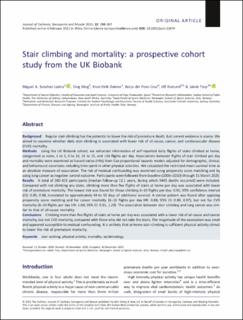| dc.contributor.author | Sanchez-Lastra, Miguel A. | |
| dc.contributor.author | Ding, Ding | |
| dc.contributor.author | Dalene, Knut Eirik | |
| dc.contributor.author | Ekelund, Ulf | |
| dc.contributor.author | Tarp, Jakob | |
| dc.contributor.author | del Pozo Cruz, Borja | |
| dc.date.accessioned | 2021-12-10T12:21:15Z | |
| dc.date.available | 2021-12-10T12:21:15Z | |
| dc.date.created | 2021-05-16T12:48:43Z | |
| dc.date.issued | 2021 | |
| dc.identifier.citation | Journal of Cachexia, Sarcopenia and Muscle. 2021, 12(2), 298-307. | en_US |
| dc.identifier.issn | 2190-5991 | |
| dc.identifier.uri | https://hdl.handle.net/11250/2833788 | |
| dc.description | This is an open access article under the terms of the Creative Commons Attribution-NonCommercial License, which permits use, distribution and reproduction in any medium, provided the original work is properly cited and is not used for commercial purposes. | en_US |
| dc.description.abstract | Background
Regular stair climbing has the potential to lower the risk of premature death, but current evidence is scarce. We aimed to examine whether daily stair climbing is associated with lower risk of all-cause, cancer, and cardiovascular disease (CVD) mortality.
Methods
Using the UK Biobank cohort, we extracted information of self-reported daily flights of stairs climbed at home, categorized as none, 1 to 5, 6 to 10, 11 to 15, and ≥16 flights per day. Associations between flights of stair climbed per day and mortality were examined as hazard ratios (HRs) from Cox proportional hazards models adjusted for demographic, clinical, and behavioural covariates including time spent in other physical activities. We calculated the restricted mean survival time as an absolute measure of association. The risk of residual confounding was examined using propensity score matching and by using lung cancer as negative control outcome. Participants were followed from baseline (2006–2010) through 31 March 2020.
Results
A total of 280 423 participants (median follow-up 11.1 years, during which 9445 deaths occurred) were included. Compared with not climbing any stairs, climbing more than five flights of stairs at home per day was associated with lower risk of premature mortality. The lowest risk was found for those climbing 6–10 flights per day: 0.91; 95% confidence interval (CI): 0.85, 0.98, translated to approximately 44 to 55 days of additional survival. A similar pattern was found after applying propensity score matching and for cancer mortality (6–10 flights per day HR: 0.88; 95% CI: 0.80, 0.97), but not for CVD mortality (6–10 flights per day HR: 1.08; 95% CI: 0.91, 1.29). The association between stair climbing and lung cancer was similar to that of all-cause mortality.
Conclusions
Climbing more than five flights of stairs at home per day was associated with a lower risk of all-cause and cancer mortality, but not CVD mortality, compared with those who did not take the stairs. The magnitude of the association was small and appeared susceptible to residual confounding. It is unlikely that at-home stair climbing is sufficient physical activity stimuli to lower the risk of premature mortality. | en_US |
| dc.language.iso | eng | en_US |
| dc.subject | epidemiology | en_US |
| dc.subject | mortality | en_US |
| dc.subject | physical activity | en_US |
| dc.subject | stair walking | en_US |
| dc.title | Stair climbing and mortality: A prospective cohort study from the UK Biobank | en_US |
| dc.type | Peer reviewed | en_US |
| dc.type | Journal article | en_US |
| dc.description.version | publishedVersion | en_US |
| dc.rights.holder | © 2021 The Authors | en_US |
| dc.source.pagenumber | 298-307 | en_US |
| dc.source.volume | 12 | en_US |
| dc.source.journal | Journal of Cachexia, Sarcopenia and Muscle | en_US |
| dc.source.issue | 2 | en_US |
| dc.identifier.doi | 10.1002/jcsm.12679 | |
| dc.identifier.cristin | 1910244 | |
| dc.description.localcode | Institutt for idrettsmedisinske fag / Department of Sports Medicine | en_US |
| cristin.ispublished | true | |
| cristin.fulltext | original | |
| cristin.qualitycode | 1 | |
